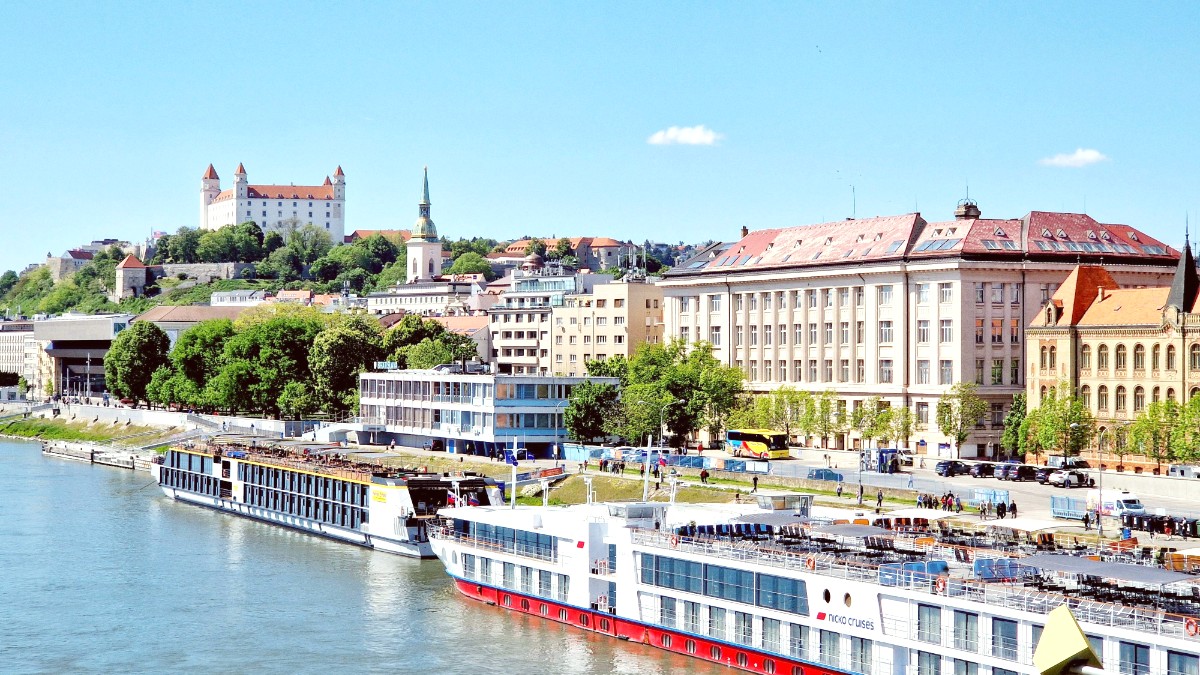
Slovakia
Temperatures in Spring (April-May) range from 10-18°C (50-64°F) with moderate rainfall. Summer (June-August) sees averages of 20-26°C (68-79°F), often rising above 30°C (86°F), with higher humidity and occasional thunderstorms. Autumn (September-October) brings cool, crisp weather, averaging 8-15°C (46-59°F).
Winter (November-March) is cold, with average temperatures between -2°C to 5°C (28-41°F). Sub-zero temperatures are common, and snow frequently covers the city, creating a picturesque setting.
Summer thunderstorms occur, often intensely, but they usually pass quickly. Winters can be harsh, with significant snowfall and icy conditions.
Waterproof winter boots are highly recommended for winter visits to keep your feet warm and dry. Consider packing a small, Compact umbrella for spring and autumn visits as sudden showers occur.
(June-August)
Warm weather, ideal for outdoor activities, river cruises, and extended strolls. The city buzzes with activity.
Higher prices for accommodation and flights. Crowded popular sites. Potential for very hot days.
(April-May, Sep-Oct)
Pleasant temperatures for sightseeing. Fewer crowds for a relaxed experience. Lower accommodation/flight prices. Beautiful blooms or foliage.
Weather can be unpredictable. Cooler temperatures or rain possible. Some outdoor attractions might have reduced hours later in autumn.
(November-March)
Lowest prices for flights and accommodation. Very few tourists. Festive Christmas market atmosphere (Nov-Dec).
Cold weather and short daylight hours. Some outdoor attractions may close. Snow and ice can affect travel.
Late spring, summer, and early autumn provide the best conditions for outdoor activities like hiking and cycling. The Little Carpathians are lovely for hiking.
The shoulder seasons (April-May, September-October) offer comfortable temperatures and fewer crowds, making walking tours enjoyable.
Late Spring, Summer, Early Autumn.
Shoulder Seasons (April-May, Sep-Oct).
Late November to late December.
Late Spring to Early Autumn.
Winter in nearby mountains.
Slovakia is part of the Schengen Area, simplifying entry for many travelers.
Citizens of many non-EU/EEA countries need a Schengen Visa (Short Stay - Type C) for stays up to 90 days. This involves submitting forms, your passport, photos, travel insurance, proof of accommodation, and financial means. Apply at the Slovak embassy or consulate in your home country well in advance.
Your passport must be valid for at least three months beyond your intended departure date from the Schengen Area. It also needs at least two blank pages for stamps.
Bratislava offers a range of prices, allowing travelers to choose a style that fits their budget. The official currency is the Euro (€).
Bratislava is generally a safe city for tourists.
Budget traveler: €30-€60/day
Hostel dorm bed (€15-€25), supermarket groceries/street food (€10-€20), public transport pass (€3-€5), free walking tours/limited paid entries (€0-€10).
Mid-range traveler: €60-€150/day
Mid-range hotel/apartment (€50-€100), casual/nicer restaurant meals (€25-€50), public transport/occasional taxi (€5-€10), several paid entries/guided tours (€10-€30).
A bed in a hostel dorm typically costs between €15 and €30 per night.
Good for solo budget travelers.
Less privacy.
Expect to pay €40 to €70 per night for a budget hotel or guesthouse.
Private room, good value.
Amenities are basic.
A mid-range hotel typically costs €70 to €120 per night.
Comfortable, more amenities.
Higher price point.
| Category | Price Range | Notes |
|---|---|---|
| Luxury Hotel (per night) | €120+ | Premium experience. |
| Street Food/Fast Food | €4 - €8 | Quick, budget-friendly meals. |
| Fine Dining (per person) | €40+ | Upscale culinary experiences. |
Bratislava is generally a safe city for tourists.
No specific vaccinations are mandatory for entry. Routine vaccinations (MMR, Diphtheria-Tetanus-Pertussis, Varicella, Polio, flu) are recommended. Consult your doctor.
A risk exists in wooded areas during warmer months. Consider vaccination if you spend significant time outdoors. Use Insect repellent with DEET when hiking.
Low risk. Tap water is safe. Practice good hand hygiene. Bring a LifeStraw if you're concerned about rural water sources.
Sunburn/Heatstroke:
During summer, apply Broad-spectrum sunscreen, wear a hat, and stay hydrated, especially during peak sun hours.
Allergies: If you have allergies, carry appropriate medication. Inform restaurant staff about food allergies using a Translation card.
No need for Bottled water for drinking as tap water is safe.
Slovakia has public and private healthcare. Quality is generally good. Private clinics offer faster appointments and English-speaking staff.
Dial 112 for general emergencies (ambulance, fire, police). This is the EU emergency number.
Widely available (Lekáreň, green cross sign). Some operate 24/7. Pharmacists offer advice for minor ailments.
Bratislava is generally a safe city for tourists. Awareness of surroundings is always wise.
Bratislava has low natural disaster risk.
Danube River can have high water levels, but significant city-center flooding is rare due to defenses.
Summer heatwaves and winter cold snaps are possible. Dress appropriately for the season.
Obtain comprehensive travel insurance. Keep emergency contact information accessible, digital and physical.